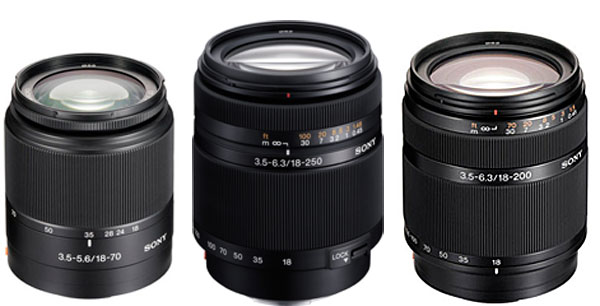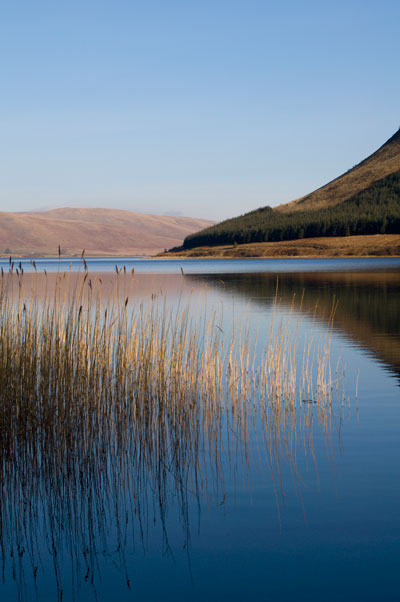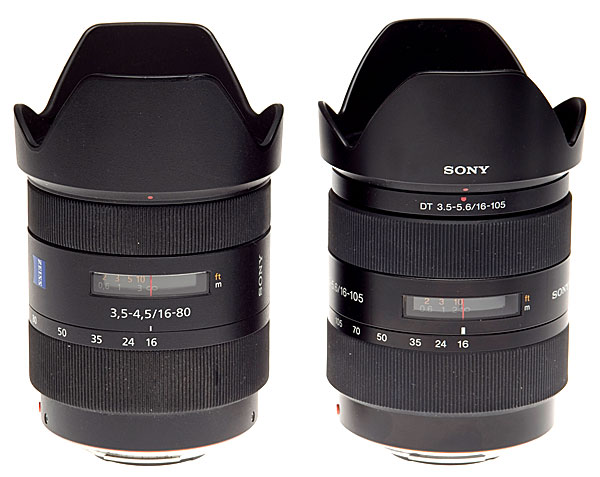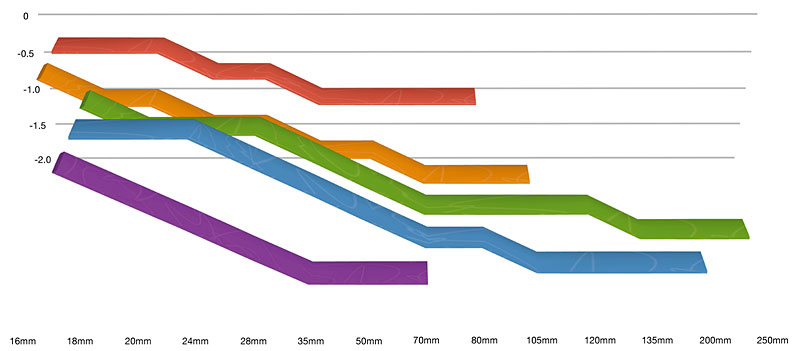Which Sony Alpha kit lens?
This article was originally published in Photoworld magazine April 2008. It discusses the reasons for choosing between the 18-70mm, 16-105mm, 16-80mm, 18-200mm and 18-250mm kit lens choices for the Sony Alpha DSLR system and has been updated as necessary from the original text.

The SAL 18-70, 18-250, and 18-200 choices
No other DSLR maker offers such a wide choice of possible standard or kit zooms as Sony. Two of the lenses, the 18-200mm and the 18-250mm, are close cousins of Tamron models with the same specifications, and in discussing them here some our opinions are based on using the Konica Minolta 18-200mm and Tamron 18-250mm, as well as the Sony 18-250mm. Tamron now has an 18-270mm option but so far there is no sign of a Sony version.
Users have different requirements. Shirley and I shoot with a different eye. I have loved extreme wide-angles since discovering 17mm on full frame film back around 1974. Shirley prefers to be able to isolate small close-up details of people, plants and animals and often ends up at the long end of any lens.
This is no bad thing when you travel and shoot side-by-side. Of course we often get a similar shot, but most of the time our angles of view are different extremes.

SK - drive-by shooting with 18-250mm at 100mm
When we last used film, Shirley’s normal lens on a Dynax 7xi was the 35-200mm ƒ3.5-5.6 xi zoom while I shot with a pair of Minolta CLE rangefinder cameras using 20mm, 28mm, 40mm, 90mm and 135mm lenses. We replaced the 35-200mm with a Tamron 28-300mm ƒ3.5-6.3 XR for travelling but the optical quality suffered. Moving to digital, I bought a Tamron 11-18mm ultrawide zoom as soon as they were available and used it with a 24-105mm and 100-300mm. Shirley got a Konica Minolta 18-200mm, the digital equivalent of the 28-300mm but much improved in performance.
When the Tamron 18-250mm arrived, with even better optics, the 18-200mm was replaced and sold. Much the same happened with the 24-105mm when the 16-80mm Carl Zeiss became available, but we kept the 24-105mm to try with the rumured Alpha 900. When the 900 arrived, even the quickest test (at the press conference) resulted in the 24-105mm hitting eBay – it’s a fine lens on APS-C, but just not good enough for full frame. I have eventually settled on a vintage 1999 Minolta RS 28-105mm f/3.5-4.5 for the Alpha 900, it’s a much better lens.
Along the line we acquired (and sold) at least three of the 18-70mm ƒ3.5-5.6 KM or Sony kit lenses, because the only cameras available were in kits.

Alpha 350, ISO 100, 1/400th at ƒ10, 16-105mm at 16mm. The bottom of the shot is cropped off; this is a useful technique to keep verticals plumb when you have extra angular coverage at 16mm. Composed using Live View held over barrier.
When it appeared, we bought a 16-105mm ƒ3.5-5.6 Sony SAL from London Camera Exchange Colchester, who had them available separately when even Sony themselves were unable to supply a review sample on its own. It’s not seen much use because we have the other lenses, but it lives on our Alpha 350 body. The 18-70mm lives in a cupboard!
So, since the launch of the Dynax 7D four years ago we have used all of the five focal length ranges of zoom offered currently under the Sony label with – or without – bodies in kits.
Which would be the best choice for you?
Cost
At the bottom end we get the basic SAL 18-70mm ƒ3.5-5.6 DT kit lens, with a nominal price of £129.50 ($199) but an actual price of around £50 ($99) when included in a kit. This lightweight lens takes 55mm filters but the front rotates as it focuses, making polarisers difficult to use. It has no focus scale, just a skinny ring behind the minimal clip-on lens hood for manual focus; when you grip this at 70mm, you can feel the entire front unit wobble freely.
Left: 18-70mm shot on Dynax 7D, in-camera JPEG; right, processed from raw with vignetting correction.
The 18-70mm is actually surprisingly good by kit lens standards, preferable to the low-cost 18-55mm models of similar (2006) date offered by other makes not just because it has a better range and wider apertures at middle focal lengths. It performs better. In 2007-8, Canon and Nikon both improved their 18-55mm designs and that advantage has been lost.
If your interests mean you need a longer lens such as the budget priced 75-300mm ƒ4.5-5.6 Sony SAL, the 18-70mm is an ideal choice to pair with it. Both are lightweight, both take 55mm filters, and they form an almost contiguous 18-300mm range. It also pairs well with the new 55-200mm ƒ4-5.6 DT lens, which is an exceptional bit of glass for its tiny price and size.
One reason for buying this type of kit might be that there are two of you – or two camera bodies.
Next up in the price group is the Sony SAL 18-200mm ƒ3.5-6.3 DT. This lens is identical to the Konica Minolta model in a redesigned finish, and lacks the zoom lock which the Tamron variant has. This lock allows you set the zoom to its shortest 18mm parked position and fix it securely, so that it can not extend with the help of gravity. Although the 18-200mm has been offered as a very good kit deal, adding under £300 to an outfit despite its £399 retail price, we would not advise it unless the apparent extra cost is less than £200 over an 18-70mm combo.

SK - St Mary's Loch, 18-200mm KM used at 50mm on a Dynax 5D
The optical performance is acceptable at the long end and superior to the 18-70mm within that range, but all of the three of the alternative wider range zooms are better. Also, the zoom action will become loose in time and you will regret not having the zoom lock.
The SAL 18-250mm ƒ3.5-6.3 DT and the SAL 16-105mm ƒ3.5-5.6 DT both sell for a little more than the remaining 18-200mms, with the 18-250mm coming in about 10% below the 16-105mm price. They are very different lenses, and here your decision is most difficult. Finding an 18-250mm bundled at a lower true cost is harder than finding a 16-105mm, which is now offered with various bodies and may add less than £300 to the combination.
The 18-250mm is very sharp between its wide angle end and the mid-100s, and it has a slightly faster maximum aperture across the 18-105mm range which coincides with the other lens. See our table of aperture change points at the end of this article to understand this.
Shirley photographed the tourist stores of Guadaleste using the Sony 18-250mm at 130mm, and ƒ6.3 (a third of a stop down from its maximum at that length). Click the image to access a full size Alpha 200 file, with no corrections applied in the raw conversion (please note – that includes NO sharpening added). Some aberrations are present to the extreme corners, more so on the left side, and there is a slight halo veiling all the (very sharp) detail. But that detail is present in spades, as the textures of the woven throws, the shop signs etc all show. The geometry is also very good.
It has just as good a geometry and does not suffer from quite such a sharp falloff in corner sharpness as the 16-105mm, and it can do far better close-ups because of the 250mm reach. It has that vital zoom lock at 18mm.
The 16-105mm has a slightly crisper central image and a significant wide-angle benefit (2mm counts for a lot – it is about the same as the difference between a 24mm and a 28mm on full frame). At no point in its range does it suffer from as much full aperture edge sharpness loss or chromatic aberration as the 18-250mm does progressively from 150mm to 250mm.
This means it counts as a better lens optically in some ways. But – it doesn’t have this range! If you restrict the 18-250mm to 18-105mm, it’s probably a ‘better lens’ than the 16-105mm. We have bought the 16-105mm to become familiar with it, but with an 18-250mm around it is almost redundant before starting.

The CZ 16-80mm and SAL 16-105mm side by side (the CZ with some months of use shows this in the dirt-trap Sony rubber barrel grips).
This brings us to the final kit lens – the ultimate in quality, the Sony Carl Zeiss 16-80mm ƒ3.5-4.5. This costs 20-25% more than either of the last two lenses. It has the wide-angle range of the 16-105mm, and was launched earlier. The long end is not ambitious, but the maximum aperture figure is important. It is between 1/3rd and 2/3rds of a stop faster than the 16-105mm in the range 18-80mm, and the same amount faster than the 18-250mm in the 50-80mm zone.

At 30mm and ƒ5.6 (1 stop down from full working aperture at this focal length) the CZ has superb colour and differential focus with a very sharp main focus point.
This extra viewfinder brightness and low light capability is helped by superb full aperture sharpness. The other two lenses really need stopping down one stop from wide open to clean up the image; the CZ does not. It can achieve quality results at one to two stops wider aperture than either.
You can visit our pBase gallery with a whole series of CZ 16-80mm shots.
Having said that, by the time you stop any of these lenses down to ƒ11, there will not be much between them. I’d say the CZ has a more luminous image with higher fine detail contrast. That’s the Zeiss T* coating at work.
Neither the 16-105mm nor 16-80mm has a zoom lock. They don’t need it. The 16-105mm feels paradoxically to be a better quality lens than the CZ. It is heavier, more solid and firm yet smooth in zoom operation, and the double extension barrel is rigid. The construction seems to be the same mix of metal and plastic (all the exterior being plastic) and the finish uses the same Sony fine ribbed grips which pick up dust and mark so easily they look second hand within five minutes of leaving the box.
Remember, our CZ 16-80mm was the third one received. Our first one had loose internal mechanisms and the image jumped when zoomed or focused, as did one further sample. Quality control on the CZ has been criticised because superb optics appear to have been put into a badly designed mount. The 16-105mm, a later design, has none of the QC issues and although it’s a much slower lens aperture-wise and lacks the bite of the Zeiss glass and coating, it is a safe buy. Read my full early review of the CZ. It has survived well, despite picking up dirt in the grip ribs, and remains solid in action (update – early 2009, still going strong).
Finally, all these more advanced kit options (18-200mm, 18-250mm, 16-80mm, 16-105mm) use 62mm filters. This makes them excellent companion lenses to the new 70-300mm ƒ4-5.6 G SSM tele zoom, which also uses 62mm; the same goes for the budget but good quality Tamron 70-300mm ƒ4-5.6 LD Di Tele Macro. A polariser is the most obvious filter to share across your lens range, and it must be a wide angle or ultra slim type to avoid cutting off corners on the 18mm or 16mm wide-angle settings.
Read my article about vignetting and polarisers. The CZ 16-80mm is the worst of the bunch for being tight on filters and really does need ultra-slim, expensive glass. The 16-105mm is next. The 18-XXXmm designs are all more tolerant of slightly thicker filters. Sony now market Carl Zeiss T* coated filters in 49mm, 55mm, 62mm, 72mm and 77mm sizes with UV/Protectors (from around £35) and circular polarisers (from around £50). I use a special wide-angle Minolta circular polariser with a flared, stepped mount on my 16-80mm.
Working apertures
What you may not realise is that the maximum aperture of these lenses changes as you zoom, in a series of steps as far as the camera is concerned (data received) but actually more gradually. Each lens changes its reported ‘full bore’ at different points. Here, you really begin to see why the CZ is better – it’s almost a stop faster most of the time:

Red: 16-80mm. Orange: 16-105mm. Green: 18-250mm. Blue: 18-200mm. Purple: 18-70mm. The graph is 3D, the only way it was clear enough, so you'll have to read it with perspective specs on. All the lines start at 0 which is their full aperture of ƒ3.5 in all cases.
In the graphic, the CZ is ƒ3.5 from 16mm then ƒ4 at 24mm to 35mm after which it is ƒ4.5 all the way. The SAL 16-105mm is only ƒ3.5 dead on 16mm, it’s ƒ4 at 18mm, ƒ4.5 by 26mm, ƒ5 around 35-50mm and ƒ5.6 all the after that to 105mm. The slopes partially smooth the steps; the camera reads in sudden 1/3rd stop steps, the lens apertures actually fall off smoothly. There is no effect on exposure accuracy.
Reasons to choose
If you want zoom range in a single lens, with very good quality from 18mm to 150mm and more than acceptable results up to 250mm if not matching a dedicated tele-zoom, the Sony SAL 18-250mm ƒ3.5-6.3 is your best choice. No matter what deals are offered, it is a far better lens than the 18-200mm and has the zoom lock.
If you want a semblance of low light capability and sharp images at all settings, the Carl Zeiss 16-80mm offers real advantages. It is not just a better lens, it is one you can use with at least a one stop advantage in wide aperture sharpness, and on average a half-stop gain in speed. It also produces better differential focus for portraits, especially if you use 80mm and ƒ4.5.
The 16-105mm is a dilemma. You might imagine it would get better close-ups than the 16-80mm; 35cm minimum focus at 80mm versus 38cm at 105mm? No! Both cover roughly 4″/10cm wide at their closest focus and longest focal length. Both are beaten by the humble 18-70mm kit lens which covers 8.5cm wide at 70mm and its closest focus.
Well, of course the 18-250mm will do better… but it doesn’t to the degree you would expect. What it gives you is a greater working distance and a little larger image scale the the 18-70mm. But it also gives you the equal best close-up capability of any current Sony zoom including the new SAL 70-300mm SSM G.
Close focus image scale
The higher the figure, the better for close-ups in this list. We can also compare the weight, and you’ll see that going for a shorter range does not save you grammes for travelling, the 16-105mm feels solid because it is the heaviest of the lot:
- SAL 18-70mm 0.25X 235g
- CZ 16-80mm 0.24X 445g
- SAL 16-105mm 0.23X 470g
- SAL 18-200mm 0.27X 405g
- SAL 18-250mm 0.29X 440g
The different zoom designs, and the way they change focal length when focusing, are responsible. The super-tele zooms are also much the same size as the shorter models as well as being lighter.
This situation applies to other lenses. The tele 55-200mm and 75-300mm low-cost kit lenses both manage 0.29X, the 75-300mm achieving this at 1.5m focus distance. You might imagine the new 70-300mm SSM would beat this comfortably with a 1.2m minimum focus. Not so – it only gets 0.25X, because it uses internal focusing which changes the real focal length.
If you want those flowers, insects, cat’s eyes, coins, stamps or anything else close-up the 18-250mm is the best ‘all in one zoom’ choice you can make short of buying a dedicated macro lens. No non-macro lens made in the entire Sony range – not the 135mm ƒ1.8, 70-200mm ƒ2.8, 24-70mm ƒ2.8, 50mm ƒ1.4 – can match the 18-250mm or the lower cost kit tele lenses for close-ups. Beware the 24-105mm, which has about the worst close-up capability of any standard zoom at 0.18X (equal to only 0.12X relative to the APS-C table above, on the full frame A900).
Hopefully, these comments and facts will help you choose the best kit lens or replacement for older lenses.
– David Kilpatrick





The graph starts at 0 for all lenses, it is not hard to read, you just need to view it as a solid not a flat graphic. 2D graphing just left the lines overlapped so much it was not possible to see them all.
Good article. The 18-250 might be a good alternative to extend the zoom range over my Minolta 24-105 after all.
But I find knock on the 24-105 at the end a bit odd. Max magnification may be less at minimum focus, but it is as fast or faster than all the others. (Graph is hard to read – why do they start at -.5 rather than 0? For that matter why not just put the actual f stop?) And as a full frame design (the others are all DT) it suffers no vignetting and has excellent corner sharpness on the A700.
Also you seem to say that the magnification will change on a full frame SLR vs. APSC. This is incorrect. Magnification ratio is exactly the same. The field of view increases with full frame (or if your prefer, crops with an apsc), but the size of the image on the sensor does not change.
Very helpful article, thanks very much!
However, I would think that the aperture graph would be a lot clearer if it was a simple 2D graph.
I hope this article gets a lot of exposure. Many folks on dpreview could really benefit from your nice detailed comparisons. Your graph of the f-stop changes is an excellent presentation.
Here is the link to all 120 (so far) of the A700 + 18-70 kit lens photos from the July 4th 2008 shoot.
http://www.illinoisphoto.com/stock-photos/v/fireworks+photos/
Happy shooting!
-Sonolta
Thanks for that story on the kits, DK. Allow me to blow this joint up with the 18-70 kit lens. First time I have used it.
http://www.illinoisphoto.com/stock-photos/v/fireworks+photos/amazing+fireworks/
The kit lens and the A700 certainly did take care of business on this great night. This baby gave me at least 150 nice shots in 30 short minutes. If you have piclens installed on your system use the giant wall, but not the slideshow, as the photos are to small and the pix will stretch…the giant 3D wall does look cool as usual. I have a beta gallery up I am running it on so it’s just fireworks in there for now.
Thanks again DK..Once again, another nice read, and the old Sony did not let us Independence Day fans down!
-Sonolta